
John Douglas (1830–1911) was an English architect based in Chester, Cheshire. His designs included new churches, alterations to and restoration of existing churches, church furnishings, new houses and alterations to existing houses, and a variety of other buildings, including shops, banks, offices, schools, memorials and public buildings. His architectural styles were eclectic, but as he worked during the period of the Gothic Revival, much of his work incorporates elements of the English Gothic style. Douglas is probably best remembered for his incorporation of vernacular elements in his buildings, especially half-timbering. Of particular importance is Douglas' use of joinery and highly detailed wood carving.
Douglas was born in the Cheshire village of Sandiway and was articled to the Lancaster architect E. G. Paley, later becoming his chief assistant. He established an office in Chester in either 1855 or 1860, from where he practised throughout his career. Initially he ran the office himself but in 1884 he appointed his assistant, Daniel Porter Fordham, as a partner. When Fordham retired in 1897, he was succeeded by Charles Howard Minshull. In 1909 this partnership was dissolved and Douglas ran the office alone until his death in 1911. As his office was in Chester, most of his work on houses was in Cheshire and North Wales, although some was further afield, in Lancashire, Merseyside, Greater Manchester, Warwickshire, Herefordshire, Worcestershire, Derbyshire, Surrey, and Scotland.
From an early stage in his career, Douglas attracted commissions from wealthy and powerful patrons, the first of which came from Hugh Cholmondeley, 2nd Baron Delamere. His most important patrons were the Grosvenor family of Eaton Hall, namely Richard Grosvenor, 2nd Marquess of Westminster; Hugh Grosvenor, 1st Duke of Westminster; and Hugh Grosvenor, 2nd Duke of Westminster. Douglas designed a large number and variety of buildings in the family's Eaton Hall estate and the surrounding villages. Other important patrons were William Molyneux, 4th Earl of Sefton; Rowland Egerton-Warburton of Arley Hall; George Cholmondeley, 5th Marquess of Cholmondeley; and Francis Egerton, 3rd Earl of Ellesmere. Later in his career Douglas carried out commissions for W. E. Gladstone and his family, and for W. H. Lever.
Douglas' new houses embrace a range of sizes and types, and include substantial country houses, such as Oakmere Hall and Abbeystead House; cottages, such as the pair known as Tai Cochion; workers' houses, such as those in Port Sunlight; and terraces of houses built for speculation, including 6–11 Grosvenor Park Road and 1–11 and 13 Bath Street in Chester. Work carried out on grand houses included additions to Vale Royal Abbey and Hawarden Castle. Works associated with houses include entrance gates for Mostyn Hall and a set of kennels at Croxteth Hall. Many of Douglas' new houses have been designated as listed buildings. Listed buildings are divided into three grades according to their importance. This list consists of work carried out by Douglas in designing new houses, additions and modifications to pre-existing houses, and structures related to houses such as kennels and gates. The details have been taken mainly from the Catalogue of Works in the biography by Edward Hubbard. Not all structures in these categories are included. If a building is listed, it has been included. Some unlisted buildings have been included because they are of interest, or they demonstrate that Douglas worked in areas at a distance away from his office in Chester. The works excluded are, on the whole, small houses, cottages and outbuildings. Works attributed to Douglas by Hubbard on stylistic grounds together with evidence of a local association, even though they are not confirmed by other reliable evidence, are included. Where this is the case, it is stated in the Notes column. Unexecuted schemes are not included.
Key
Map all coordinates using OpenStreetMapDownload coordinates as:
| Grade (England and Wales) |
Criteria | ||||||||||||
|---|---|---|---|---|---|---|---|---|---|---|---|---|---|
| Grade I | Buildings of exceptional interest, sometimes considered to be internationally important. | ||||||||||||
| Grade II* | Particularly important buildings of more than special interest. | ||||||||||||
| Grade II | Buildings of national importance and special interest. | ||||||||||||
| Category (Scotland) |
Criteria | ||||||||||||
| Category B | Buildings of special architectural or historic interest which are major examples of a particular period, style or building type. | ||||||||||||
| "—" denotes a work that is not graded. | |||||||||||||
Houses and associated buildings
|
          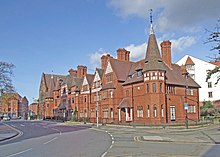 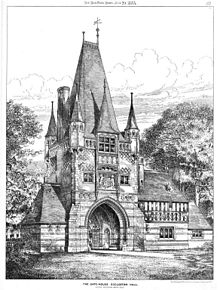    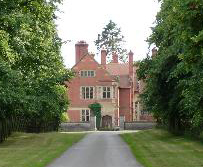  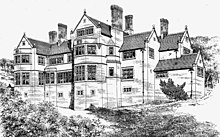  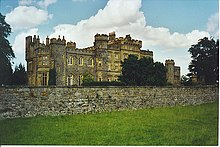     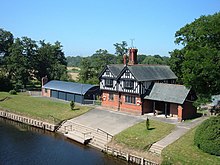      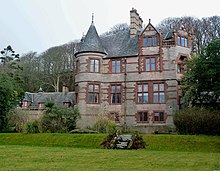 |
See also
- List of new churches by John Douglas
- List of church restorations, amendments and furniture by John Douglas
- List of non-ecclesiastical and non-residential works by John Douglas
References
Citations
- ^ Howell, Peter (2004) 'Douglas, John (1830–1911)', Oxford Dictionary of National Biography, Oxford University Press John Douglas, retrieved on 22 January 2008 (subscription or UK public library membership required)
- John Douglas, Dictionary of Scottish Architects, retrieved 19 December 2016
- Hubbard 1991, p. 95.
- Hubbard 1991, pp. 84–87.
- Hubbard 1991, pp. 3–4. Hubbard states "There is confusion as to the date at which Douglas established his own practice in Chester, with it not being clear if this was in 1855 or 1860".
- Hubbard 1991, pp. 6–7.
- ^ Hubbard 1991, pp. 238–279.
- "Listed Buildings", Historic England, retrieved 29 March 2015
- Hubbard 1991, p. 238.
- "Listed Buildings", Historic England, retrieved 26 August 2011
- What is Listing?: Categories of listed building, Historic Environment Scotland, retrieved 3 July 2020
- Hubbard 1991, pp. 40–41, 238, 248.
- Hartwell et al. 2011, pp. 646–649.
- Historic England, "Vale Royal Abbey (1160862)", National Heritage List for England, retrieved 29 September 2011
- Hubbard 1991, pp. 80, 277, 280.
- Pollard & Pevsner 2006, p. 409.
- Historic England, "Kennels at Croxteth Hall (1206369)", National Heritage List for England, retrieved 29 September 2011
- Hubbard 1991, pp. 28, 46–, 48, 239.
- Hartwell et al. 2011, p. 250.
- Historic England, "Park Lodge, Grosvenor Park (1375828)", National Heritage List for England, retrieved 29 September 2011
- ^ Hubbard 1991, p. 240.
- Hartwell et al. 2011, p. 518.
- Historic England, "Burford Lane Farmhouse (1226461)", National Heritage List for England, retrieved 29 September 2011
- Hubbard 1991, pp. 50–54, 240.
- Hartwell et al. 2011, p. 582.
- King, Roger, John Douglas, Northwich: Northwich & District Historical Society, p. 6
- Historic England, "Oakmere Hall (1313106)", National Heritage List for England, retrieved 29 September 2011
- Historic England, "Dene Cottages, Great Budworth (1329854)", National Heritage List for England, retrieved 29 September 2011
- Hubbard 1991, pp. 240, 243.
- Hubbard 1986, pp. 408–410.
- Cadw, "Soughton Hall (Grade II*) (547)", National Historic Assets of Wales, retrieved 23 January 2020
- Hubbard 1991, pp. 5, 56–58, 240.
- ^ Hartwell et al. 2011, p. 281.
- Historic England, "Beauford Lodge and front garden walls and gatepiers, Chester (1375759)", National Heritage List for England, retrieved 29 September 2011
- Hubbard 1991, pp. 95, 241.
- ^ Hartwell et al. 2011, p. 354.
- Historic England, "Church House, Eccleston (1136369)", National Heritage List for England, retrieved 29 September 2011
- Hubbard 1991, p. 242.
- Historic England, "Jasmine Cottage, Great Budworth (1139118)", National Heritage List for England, retrieved 29 September 2011
- Hubbard 1991, pp. 97, 242.
- Historic England, "The Vicarage, Polesworth (1262201)", National Heritage List for England, retrieved 29 September 2011
- ^ Hubbard 1991, p. 278.
- Historic England, "Goldmine House, Rose Cottage, Great Budworth (1329888)", National Heritage List for England, retrieved 29 September 2011
- Hubbard 1991, p. 243.
- Cadw, "Plas Tan-y-Bwlch including attached terrace walls to east and west (Grade II*) (4702)", National Historic Assets of Wales, retrieved 22 June 2020
- Hubbard 1991, pp. 101–103, 243.
- Hartwell et al. 2011, p. 550.
- Historic England, "Green Paddocks, Pulford (1136635)", National Heritage List for England, retrieved 29 September 2011
- Hubbard 1991, pp. 115, 243, 275.
- Hartwell et al. 2011, p. 381.
- Historic England, "Shotwick House (1115438)", National Heritage List for England, retrieved 29 September 2011
- Hubbard 1991, pp. 105, 107, 244.
- Hartwell et al. 2011, p. 188.
- Historic England, "Broxton Old Hall (1229906)", National Heritage List for England, retrieved 29 September 2011
- Hartwell et al. 2011, p. 511.
- Historic England, "Ruloe House (1139195)", National Heritage List for England, retrieved 25 September 2011
- ^ Hubbard 1991, p. 246.
- Hartwell et al. 2011, pp. 360–361.
- Historic England, "Outbuildings at Hill Bark Farm (1259871)", National Heritage List for England, retrieved 29 March 2015
- Historic England, "Hill Bark Farmhouse (1242749)", National Heritage List for England, retrieved 29 September 2011
- Hubbard 1986, pp. 338–339.
- ^ Hubbard 1991, p. 248.
- Hubbard 1986, p. 445.
- Listed buildings in Wales: The Gelli, Cadw, 2009
- Hubbard 1986, p. 402.
- Cadw, "1 Tai Cochion, Nannerch (Grade II) (26906)", National Historic Assets of Wales, retrieved 22 June 2020
- Cadw, "2 Tai Cochion, Nannerch (Grade II) (26907)", National Historic Assets of Wales, retrieved 22 June 2020
- Hubbard 1991, pp. 90, 248.
- Historic England, "Alford Lodge to Eaton Park and attached Avenue Cottage (1330590)", National Heritage List for England, retrieved 29 September 2011
- Historic England, "Upper Belgrave Lodge, Eaton Park (1136146)", National Heritage List for England, retrieved 29 September 2011
- Hubbard 1991, p. 249.
- Historic England, "Eaton Boat and attached storeshed and domestic offices (1129925)", National Heritage List for England, retrieved 29 September 2011
- Hubbard 1991, pp. 105, 249.
- Hartwell et al. 2011, p. 667.
- Hubbard 1991, pp. 107–109, 249.
- Hubbard 1986, p. 416.
- ^ Hubbard 1991, p. 250.
- Historic England, "Model Cottage, Cuddington (1227818)", National Heritage List for England, retrieved 29 September 2011
- Hubbard 1991, pp. 113–114, 250.
- ^ Hartwell et al. 2011, p. 273.
- Historic England, "6–11 Grosvenor Park Road, Chester (1375834)", National Heritage List for England, retrieved 29 September 2011
- Hubbard 1991, pp. 116, 250.
- Hartwell et al. 2011, p. 276.
- Historic England, "Old Vicarage and Parish Room to Church of St Thomas of Canterbury, Chester (1375900)", National Heritage List for England, retrieved 29 September 2011
- Hubbard 1991, pp. 109–110, 250.
- Hartwell et al. 2011, p. 656.
- Historic England, "The Bent Farmhouse, Warburton (1067898)", National Heritage List for England, retrieved 29 September 2011
- ^ Historic England, "Police House, Eccleston (1138413)", National Heritage List for England, retrieved 29 September 2011
- Hubbard 1991, pp. 119, 250.
- Hartwell et al. 2011, p. 351.
- Historic England, "Eccleston Hill Lodge (1136352)", National Heritage List for England, retrieved 29 September 2011
- Hubbard 1991, pp. 109, 251.
- Hartwell et al. 2011, p. 95.
- Hubbard 1991, pp. 93, 251.
- Historic England, "Aldford Hall (1129947)", National Heritage List for England, retrieved 29 September 2011
- Hubbard 1991, pp. 68, 118–119, 251, 262.
- Historic England, "Eccleston Hill (1330221)", National Heritage List for England, retrieved 29 September 2011
- Hubbard 1991, pp. 117–118, 252.
- Hubbard 1991, pp. 119–120, 253.
- Historic England, "Eccleston Paddocks (1138377)", National Heritage List for England, retrieved 29 September 2011
- Hubbard 1991, pp. 148, 253.
- Hubbard 1986, p. 118.
- Cadw, "Wigfair Hall, Cefnmeiriadog (Grade II*) (19925)", National Historic Assets of Wales, retrieved 22 June 2020
- Hubbard 1991, pp. 33, 109–111, 253.
- Cadw, "Plas Mynach, a 496, Hendremynach, Barmouth (Grade II*) (5244)", National Historic Assets of Wales, retrieved 22 June 2020
- Hubbard 1991, pp. 147–148, 254.
- Hubbard 1986, pp. 351–352.
- Cornist Hall, Cornist Hall, archived from the original on 27 January 2010, retrieved 2 December 2009
- Hubbard 1991, pp. 151, 255.
- Hartwell et al. 2011, p. 417.
- Historic England, "Terra Nova School, Twemlow (1231670)", National Heritage List for England, retrieved 29 September 2011
- Hubbard 1991, pp. 149–150, 255, 261, 264.
- Hartwell & Pevsner 2009, p. 487.
- Historic England, "Abbeystead, Over Wyresdale (1071597)", National Heritage List for England, retrieved 29 September 2011
- Hubbard 1991, pp. 151, 256.
- Hubbard 1986, p. 359.
- Cadw, "Halkyn Castle and attached Stable Block, Halkyn (Grade II*) (17792)", National Historic Assets of Wales, retrieved 22 June 2020
- ^ Hubbard 1991, p. 256.
- Historic Environment Scotland, "Greennock Road, Danefield House, stables, lodge and gatepiers (Category B Listed Building) (LB37169)", retrieved 3 July 2020
- ^ Hubbard 1986, p. 279.
- Cadw, "Coetmor (Grade II) (87324)", National Historic Assets of Wales, retrieved 22 June 2020
- Cadw, "Dedwyddfa (Grade II) (87325)", National Historic Assets of Wales, retrieved 22 June 2020
- Hubbard 1991, pp. 165, 257.
- Historic England, "Eccleston Ferry Farmhouse (1130635)", National Heritage List for England, retrieved 29 September 2011
- Hubbard 1991, pp. 157, 257, 258.
- Hubbard 1986, pp. 362–364.
- Hawarden Castle, National Monuments Record of Wales, archived from the original (PDF) on 27 July 2011, retrieved 25 March 2009
- Hubbard 1991, pp. 166–167, 258.
- Historic England, "Parker's Buildings, Chester (1375809)", National Heritage List for England, retrieved 29 September 2011
- Hubbard 1991, p. 258.
- Cadw, "Gloddaeth Hall (Grade I) (3411)", National Historic Assets of Wales, retrieved 22 June 2020
- Hartwell et al. 2011, p. 350.
- ^ Hubbard 1991, p. 259.
- Historic England, "Belgrave Lodge and storesheds, and domestic offices (1129922)", National Heritage List for England, retrieved 29 September 2011
- Historic England, "Green Farmhouse, Poulton (1330227)", National Heritage List for England, retrieved 29 September 2011
- Hubbard 1991, p. 260.
- Historic England, "Abbotsford, Cuddington (1287519)", National Heritage List for England, retrieved 29 September 2011
- Hubbard 1991, pp. 157, 262.
- Hubbard 1991, pp. 168–171, 261, 264–265, 267–271.
- Hartwell et al. 2011, pp. 532–534, 537–542.
- For example:
- Historic England. "10–16 Boundary Road, Bebington (1183661)". National Heritage List for England. Retrieved 29 September 2011.
- Historic England, "71–75 Bolton Road, Bebington (1343457)", National Heritage List for England, retrieved 29 September 2011
- Historic England, "3–9 Bridge Street, Bebington (1343460)", National Heritage List for England, retrieved 29 September 2011
- Historic England, "7–15 Corniche Road, Bebington (1183972)", National Heritage List for England, retrieved 29 September 2011
- Historic England, "128–132 New Chester Road, Bebington (1343506)", National Heritage List for England, retrieved 29 September 2011
- Historic England, "244–248 New Chester Road, Bebington (1075430)", National Heritage List for England, retrieved 29 September 2011
- Historic England, "268–274 New Chester Road, Bebington (1075431)", National Heritage List for England, retrieved 29 September 2011
- Historic England, "284–286 New Chester Road, Bebington (1075432)", National Heritage List for England, retrieved 29 September 2011
- Historic England, "294–296 New Chester Road, Bebington (1185046)", National Heritage List for England, retrieved 29 September 2011
- Historic England, "19–23 Park Road, Bebington (1075436)", National Heritage List for England, retrieved 29 September 2011
- Historic England, "55–67 Pool Bank, Bebington (1075406)", National Heritage List for England, retrieved 29 September 2011
- Historic England, "6–14 Primrose Hill, Bebington (1075410)", National Heritage List for England, retrieved 29 September 2011
- Historic England, "17–23 Wood Street, Bebington (1075395)", National Heritage List for England, retrieved 29 September 2011
- Historic England, "49–55 Wood Street, Bebington (1075397)", National Heritage List for England, retrieved 29 September 2011
- Hubbard 1991, pp. 155–156, 262.
- ^ Historic England, "Brocksford Hall and attached stable block (1237732)", National Heritage List for England, retrieved 3 October 2011
- Birkdale School, Birkdale School, archived from the original on 24 December 2009, retrieved 23 December 2009
- Residential Developments, Magfern Estates, archived from the original on 5 January 2009, retrieved 23 December 2009
- Hubbard 1991, pp. 152, 263.
- Hubbard 1986, p. 141.
- Cadw, "Llety'r Dryw (Grade II) (14665)", National Historic Assets of Wales, retrieved 22 June 2020
- Hubbard 1991, pp. 168, 264.
- Hartwell, Hyde & Pevsner 2004, pp. 672–675.
- Historic England, "Wardley Hall (1215022)", National Heritage List for England, retrieved 3 October 2011
- Hubbard 1991, pp. 151–152.
- Hubbard 1991, p. 264.
- Historic England, "Iron Bridge Lodge (1138387)", National Heritage List for England, retrieved 3 October 2011
- Hubbard 1991, pp. 265, 267.
- ^ Hartwell, Hyde & Pevsner 2004, p. 685.
- ^ Hubbard 1991, p. 265.
- Hartwell et al. 2011, p. 570.
- Historic England, "Abbey Gate College, Saighton (1136660)", National Heritage List for England, retrieved 3 October 2011
- Hubbard 1991, pp. 188, 266.
- Historic England, "Walmoor House, Dee Banks, Chester (1375760)", National Heritage List for England, retrieved 3 October 2011
- Listed buildings in Wales: Flintshire, Cadw, 2009
- Hubbard 1991, p. 267.
- Hubbard 1986, p. 401.
- Cadw, "Entrance piers, gates and bridge to Mostyn Hall (Grade II) (26263)", National Historic Assets of Wales, retrieved 22 June 2020
- Hubbard 1991, pp. 170, 187, 267.
- Hartwell et al. 2011, pp. 634–636.
- Historic England, "Thornton Manor, Bebington (1075420)", National Heritage List for England, retrieved 3 October 2011
- Hubbard 1991, p. 269.
- Listed buildings in Wales: Powys, Cadw, 2009
- Cadw, "Hen llys (Grade II) (18224)", National Historic Assets of Wales, retrieved 22 June 2020
- Hubbard 1991, p. 274.
- Historic England, "Colshaw Hall, Peover Superior (1139278)", National Heritage List for England, retrieved 3 October 2011
- Hartwell et al. 2011, p. 272.
- Hubbard 1991, pp. 193–194, 273.
- Historic England, "1–11 Bath Street, Chester (1375694)", National Heritage List for England, retrieved 3 October 2011
- Historic England, "The Spinney, 13 Bath Street, Chester (1375695)", National Heritage List for England, retrieved 3 October 2011
- Hubbard 1991, pp. 2, 275.
- Redwalls Private Nursing Home, Redwalls Nursing Home, archived from the original on 24 January 2010, retrieved 4 October 2009
- Historic England, "Redwalls, Sandiway (1227732)", National Heritage List for England, retrieved 3 October 2011
Sources
- Hartwell, Clare; Hyde, Matthew; Hubbard, Edward; Pevsner, Nikolaus (2011) , Cheshire, The Buildings of England, New Haven and London: Yale University Press, ISBN 978-0-300-17043-6
- Hartwell, Clare; Hyde, Matthew; Pevsner, Nikolaus (2004), Lancashire: Manchester and the South-East, The Buildings of England, New Haven: Yale University Press, ISBN 0-300-10583-5
- Hartwell, Clare; Pevsner, Nikolaus (2009) , Lancashire: North, The Buildings of England, New Haven and London: Yale University Press, ISBN 978-0-300-12667-9
- Hubbard, Edward (1986), The Buildings of Wales: Clwyd, London: Penguin, ISBN 0-14-071052-3
- Hubbard, Edward (1991), The Work of John Douglas, London: The Victorian Society, ISBN 0-901657-16-6
- Pollard, Richard; Pevsner, Nikolaus (2006), The Buildings of England: Lancashire: Liverpool and the South-West, New Haven & London: Yale University Press, ISBN 0-300-10910-5
External links
![]() Media related to John Douglas (architect) at Wikimedia Commons
Media related to John Douglas (architect) at Wikimedia Commons
| John Douglas | |
|---|---|
| Works | |
Categories: